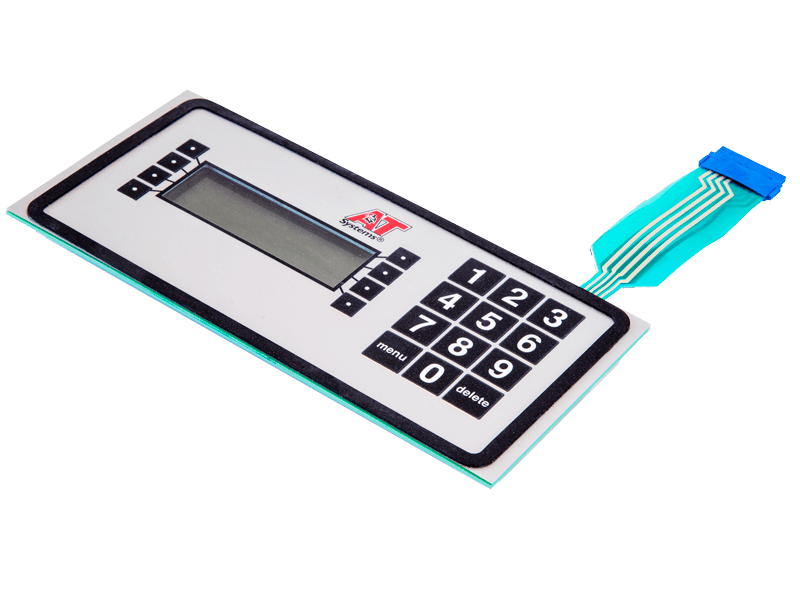Established Membrane Switch Manufacturer for Premium Control Panels
Comprehending the Relevance of Membrane Switch in Modern Electronic Devices and Their Applications
Membrane switches work as a vital element in contemporary electronic devices, supplying a reliable user interface for customer communication. Their customizable and lightweight nature makes them suitable for a variety of applications across diverse industries. Understanding their key components and benefits can give understandings right into their expanding relevance. As technology continues to advance, the evolution of Membrane switches questions about their future applications and design innovations. What exists ahead in this vibrant area?

What Are Membrane Switches?
Membrane switches are necessary parts in contemporary electronics, functioning as user interfaces that facilitate communication between tools and users. These buttons include numerous layers, including a visuals overlay, a glue layer, and a circuit layer, all of which collaborate to create a long lasting and useful interface. The design permits a level, inconspicuous solution that can be tailored regarding dimension, form, and visual look, making them suitable for different applications, from customer electronic devices to medical tools. The tactile comments provided by Membrane switches over enhances user experience, while their resistance to dust and dampness makes them perfect for testing settings. Membrane switches can integrate functions such as backlighting and printed graphics, additionally increasing their use. Their versatility and toughness make them a recommended selection in industries where dependability and convenience of usage are extremely important, eventually adding to the seamless operation of modern electronic devices.
Key Components of Membrane Switches
While various components add to the capability of a membrane switch, three primary layers play considerable functions in its style and operation. The top layer, generally made from a resilient polymer, works as the user interface for individual interaction, often including published graphics and symbols. Beneath this is the spacer layer, which maintains the necessary distance between the top layer and the circuit layer. This spacer layer warranties that the button triggers only when pressed, stopping unintentional inputs. Ultimately, the circuit layer consists of conductive traces that finish the electrical circuit when the top layer is depressed. These traces can be made from various materials, including copper or silver. With each other, these parts develop a durable and trustworthy device that is small and versatile, suitable for a large range of digital applications, from family appliances to clinical devices. Recognizing these vital parts is crucial for appreciating the overall capability of Membrane switches.
Benefits of Using Membrane Switches Over

Membrane Switch Production Process
Recognizing the Membrane switch production procedure discloses the detailed actions entailed in generating these crucial elements. The process commonly begins with the design phase, where layouts and specifications are developed making use of specialized software application. Following this, the visuals overlay is printed on an adaptable substratum, commonly utilizing high-resolution printing methods to ensure clarity and precision.Next, the adhesive layers are used, which serve to bond the numerous components together. The circuit layers, made from conductive inks or materials, are then published onto a different substrate. These layers are very carefully lined up and laminated to produce a useful switch.After setting up, the switches undergo examining to validate performance and toughness. Quality control procedures are implemented throughout the process to determine and correct any defects. Ultimately, the finished Membrane buttons are packaged and gotten ready for distribution, prepared to satisfy the needs of modern electronic applications.
Applications of Membrane Switches Over in Various Industries
Membrane buttons are progressively made use of across different sectors, particularly in medical tools and consumer electronic devices. In the medical area, they supply dependable control interfaces for gadgets that call for specific procedure. Similarly, in customer electronics, these buttons boost individual communication by providing streamlined and receptive interfaces.
Medical Tools Control
Countless modern-day clinical gadgets utilize Membrane buttons for streamlined operation and enhanced customer communication. These buttons supply a reputable, resilient interface for a variety of applications, consisting of analysis devices, person tracking systems, and medical tools. Their personalized styles enable details layouts that can fit the one-of-a-kind demands of health care professionals, making certain user-friendly navigating and effective accessibility to vital features. Furthermore, Membrane switches are resistant to contaminants, making them appropriate for sterilized settings. The responsive responses they offer can improve individual confidence, minimizing the threat of mistakes throughout essential clinical treatments. Overall, the assimilation of Membrane switches in medical devices significantly adds to enhanced operational effectiveness and individual safety and security in medical care setups.
Customer Electronic Devices Interfaces
In the domain name of consumer electronics, Membrane switches play an essential duty in improving interface across a broad variety of devices. These switches are integral to products such as remotes, microwaves, and pc gaming consoles, giving a reliable and straightforward interface. Their design permits a smooth combination of graphics and performance, allowing manufacturers to create streamlined, contemporary looks without jeopardizing usability. Membrane buttons are also understood for their durability, typically holding up against comprehensive use and direct exposure to different environmental problems. Furthermore, they can incorporate attributes like backlighting and responsive feedback, more enhancing the user experience. As customer demands for innovative yet user-friendly interfaces expand, Membrane switches over proceed to be an important element beforehand digital tool functionality.
Design Considerations for Membrane Switches
Designing effective Membrane switches needs cautious interest to different aspects that affect both performance and customer experience. One important factor to consider is the option of products, as they can affect durability, responsive feedback, and visual allure. Selecting a suitable adhesive is important for guaranteeing long-lasting attachment and resistance to environmental factors.In addition, the layout and style of the switch must fit customer interaction, with button dimensions and spacing optimized for simplicity of usage. The incorporation of graphics and labeling ought to prioritize clarity and presence under numerous lighting conditions.Consideration of electrical attributes, such as actuation pressure and switch sensitivity, will boost the responsiveness of the Membrane button. The style needs to accommodate producing processes to assure cost-effectiveness and timely production. Overall, a well-balanced style enhances both the performance and the user experience of Membrane switches in modern-day electronics.

Future Patterns in Membrane Switch Technology
As technology remains to develop, Membrane switches are poised to integrate brand-new advancements that will certainly improve their capability and application in different fields. One substantial fad is the incorporation of adaptable and resilient materials, which will certainly increase the lifespan and dependability of these buttons. Enhanced surface appearances and adjustable graphics are additionally expected, permitting more instinctive user interfaces.Moreover, the combination of clever technology, such as touch-sensitive surface areas and haptic comments, is anticipated to improve individual communication, making Membrane changes a lot more engaging and receptive. Additionally, advances in published electronics will make it possible for a lot more intricate circuitry within thinner profiles, further expanding design possibilities.Sustainability will certainly likewise go to these guys play an important duty in future advancements, as producers discover environment-friendly products and manufacturing procedures. Generally, these trends will certainly guarantee that Membrane switches continue to be indispensable and relevant in an interconnected and increasingly electronic world.
Often Asked Questions
Exactly How Do Membrane Changes Contrast to Conventional Mechanical Switches?
Membrane switches over deal benefits over conventional mechanical buttons, including lowered size, lighter weight, and enhanced durability. They normally provide a sealed surface area, improving resistance to dust and wetness, making them perfect for diverse applications.
What Products Are Typically Used in Membrane Switch Construction?

Can Membrane Switches Withstand Extreme Environmental Conditions?
Membrane switches can endure extreme environmental conditions, depending upon their style and materials. High-grade building and constructions commonly include toughness versus temperature level variations, humidity, and exposure to chemicals, making them suitable for numerous requiring applications across sectors.
For How Long Do Membrane Changes Usually Last Before Failure?
Membrane switches over commonly display a life expectancy varying from 1 to 10 million actuations, depending upon elements such as use frequency, environmental conditions, and producing quality. Normal upkeep can prolong their sturdiness and functional reliability substantially.
Are Membrane Switches Personalized for Certain Applications?
Membrane buttons are without a doubt adjustable for certain applications. They can be tailored in size, More Bonuses style, and capability, allowing basics makers to meet one-of-a-kind user demands and boost item aesthetic appeals while maintaining functional efficiency and toughness. Membrane switches are necessary components in modern-day electronics, offering as user interfaces that help with communication between tools and users. The tactile comments given by Membrane switches enhances user experience, while their resistance to dust and moisture makes them perfect for challenging atmospheres. The consolidation of graphics and labeling need to prioritize clearness and presence under various illumination conditions.Consideration of electric characteristics, such as actuation pressure and button sensitivity, will improve the responsiveness of the Membrane switch. Improved surface textures and customizable graphics are also anticipated, allowing for more user-friendly customer interfaces.Moreover, the combination of clever technology, such as touch-sensitive surfaces and haptic comments, is expected to improve user interaction, making Membrane switches much more responsive and appealing. Membrane switches deal benefits over standard mechanical switches, consisting of lowered dimension, lighter weight, and boosted sturdiness.